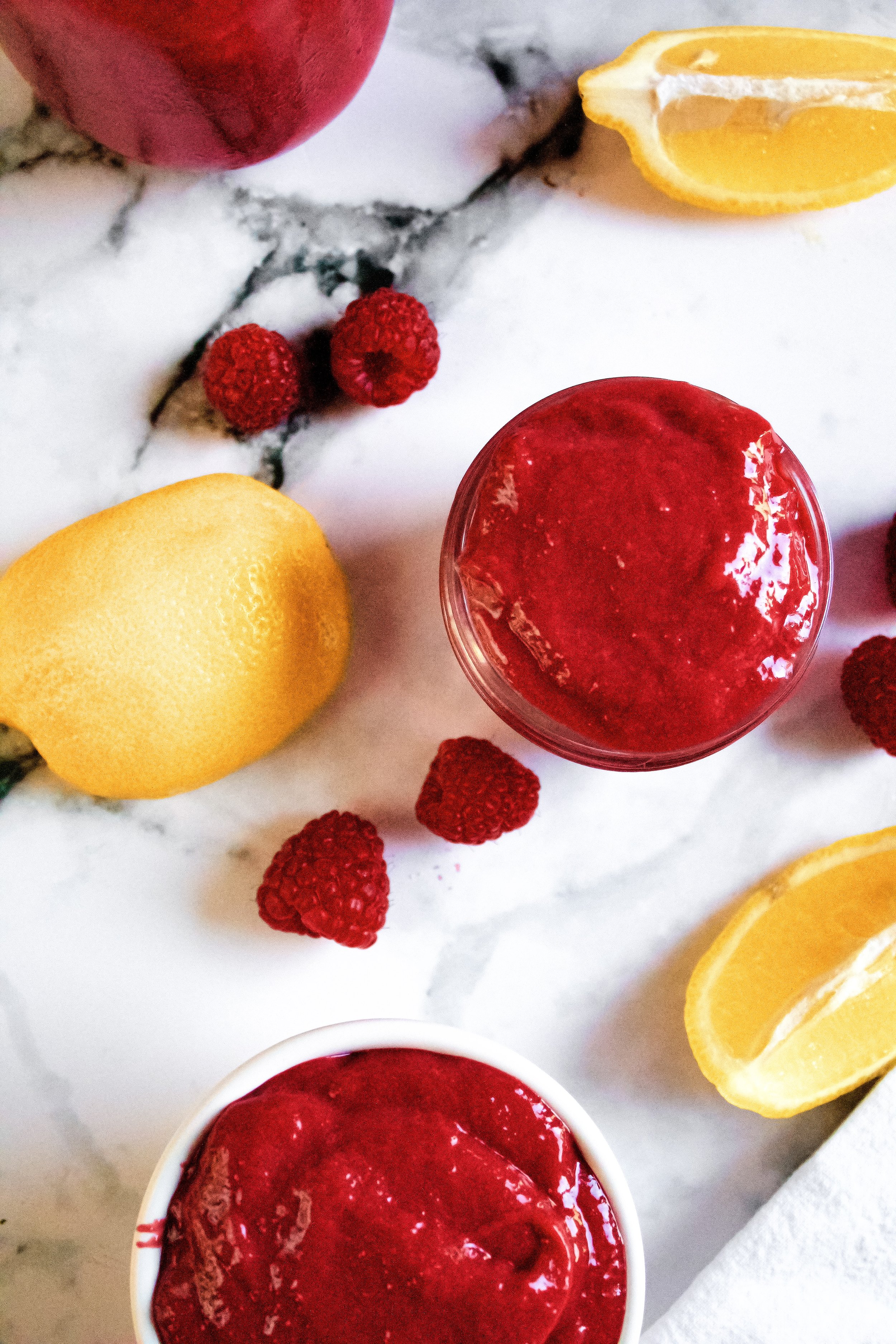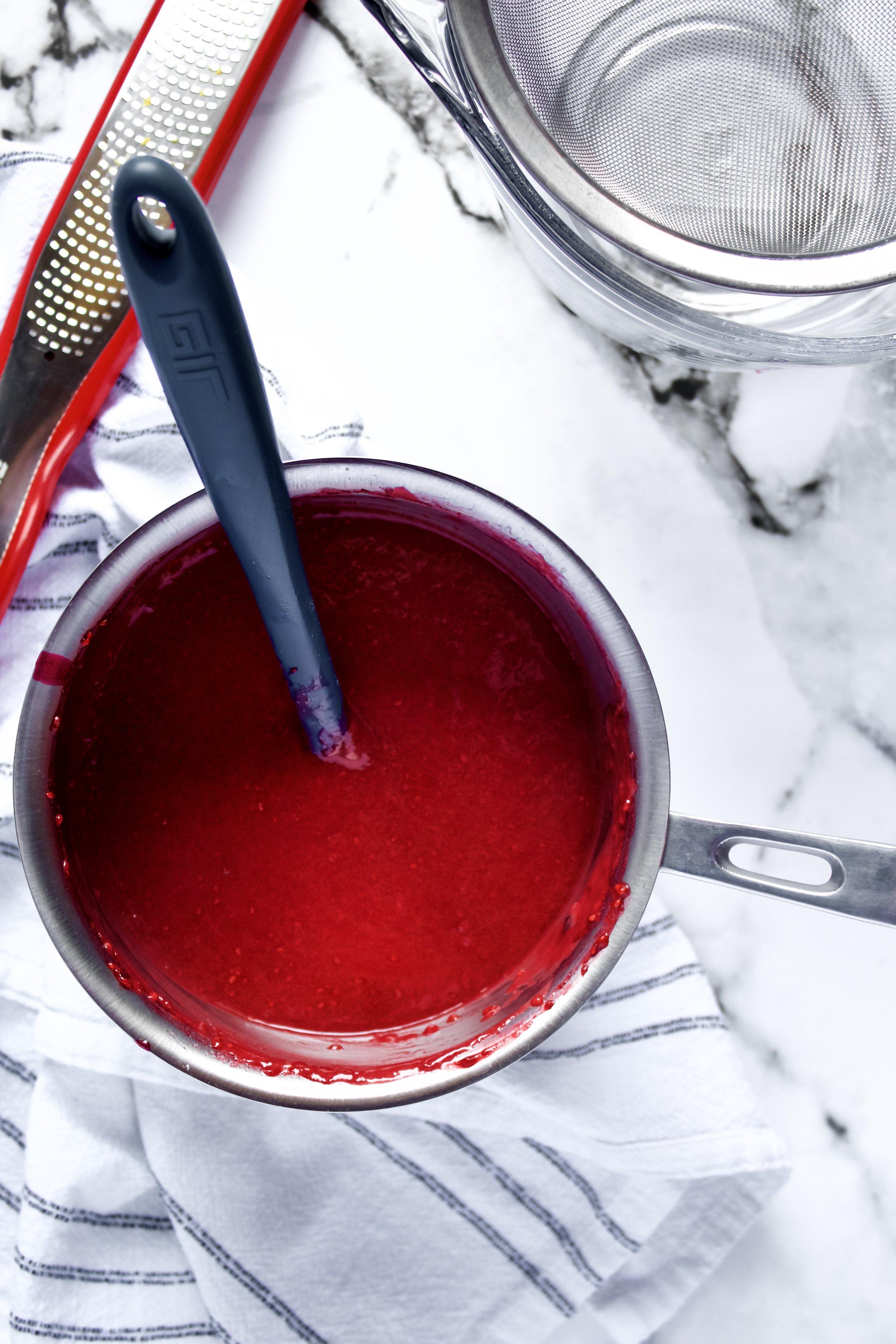Lemon Raspberry Curd
Tart yet sweet raspberry curd with a hint of lemon and the smoothest texture. This recipe is a fun, fruity twist on the classic lemon curd and is a lovely spread to use in cupcakes, tarts, or with scones!
This post may contain affiliate links from which, at no additional cost to you, I may earn a small commission to keep this site running. Only products I myself would or do use are recommended.
Am I the only one who loves lemon curd but also thinks the name is really weird? Like, curd is that chunky stuff in cream (e.g. curds and whey). Curd is related to cheese. “Curd” doesn’t begin to describe the lovely textures and tastes of lemon curd or any of its relatives.
Who started this trend of calling what’s basically a lemon butter lemon curd???
There’s probably a history there that’s utterly fascinating. But I’m going to stick with thinking it’s bizarre.
Perhaps I’m so indignant because I love all the curds so much. I have a very tart yet creamy lemon curd that I love (my trick is using extra eggs and less butter). I’ve made blueberry clementine curd that’s so rich in blueberry flavor and more on the earthy/sweet side. And then there’s raspberry curd. I’ve made this several times over the years, and it’s probably my favorite. Raspberries and lemons go so well together, with a bit of sweet and a bit of tart.
This is perfect as a tart or cake or cupcake filling, but I especially love it with scones. Sure, lemon curd is classic. But raspberry just adds something so fun and colorful!
Why this recipe works
First, fresh raspberries and lemon zest are cooked down until the juices are released and they’ve thickened somewhat. One key is to double strain it to get all seeds and zest out but still retain the wonderful flavors. You’ll then thicken this slightly with lemon juice and cornstarch, which helps add insurance that your curd will be nice and sturdy. Carefully tempering the juice into the eggs helps ensure a thick and sturdy yet creamy texture. Finally, butter helps smooth it all out a bit and keep it at that shiny, soft form instead of hardening in the fridge.
Key ingredients
Raspberries. I’ve used fresh and frozen for this recipe and both work fine. I do prefer the taste of fresh raspberries every so slightly, but both make a delicious curd.
Lemons. You’ll need the zest and juice, so try to get fresh, organic lemons.
Sugar. While the raspberries have some natural sugar, you’ll need a bit more to make the perfect curd.
Cornstarch. Just a bit to help stabilize the curd, given the fact that you’re using so much juice from the raspberries and lemons.
Egg yolks. Use room temperature eggs. You can save the whites for a healthy breakfast or use it to make homemade marshmallow fluff or homemade angel food cake!
Sea salt. Just a pinch. You can omit this and use salted butter instead.
Unsalted butter. Just a bit, to make this smooth and perfectly soft. Be sure to use room temperature butter so it melts easily into the finished curd.
How to make lemon raspberry curd
1. Cook the raspberries with sugar and lemon zest. Cook until the berries have fully broken down and the sugar is fully dissolved, about 5-10 minutes. Strain the seeds and zest out.
2. Thicken with lemon juice and cornstarch. Be sure to whisk quickly as you slowly stream in the juice/cornstarch mixture so it mixes well and doesn’t clump up as it touches the hot mixture. Cook for 5 minutes to partially thicken it. You’ll cook it more after adding the yolks, so don’t overdo it, as cooking cornstarch for too long will cause it to break.
3. Temper into egg yolks. Pour slowly and whisk quickly. I always add all of my hot liquid to the eggs to ensure I’ve properly heated the eggs before returning to the hot pan.
4. Cook until thickened. Only cook 5-10 minutes more, until thickened to desired consistency. It will thicken slightly as it cools.
5. Strain again. This is to remove any eggs that scrambled as well as any seeds or zest that was left behind.
6. Stir in butter and salt. Stir until melted and fully combined. Then you’re done!
7. Let cool completely before using. I usually pour it back into the bowl that the eggs were in then place a piece of plastic wrap directly touching the top of the curd, so a skin doesn’t form. However, you could place it in a jar and seal it. Just be sure to stir before using, which is sometimes difficult in a full-to-the-brim jar.
Enjoy!
Pairs well with:
While this goes well in just about anything, these are my favorite pairings!
Use instead of lemon curd to brighten up these lemon vanilla cupcakes!
Pair with my all-time favorite scone recipe
Turn this lemon curd tart into a lemon raspberry tart!
Make this strawberry lemonade cake into a raspberry lemonade cake! Only use a thin layer of curd to avoid the layers sliding around.
Tips and FAQ’s for this recipe
Do I have to strain it twice?
Yes. I’m unbelievably lazy, so if I say strain something, you can bet it’s necessary. The first strain is to remove the seeds and zest so that as you cook the curd, you know exactly how much it’s thickened. Leaving the seeds until the end will give a false sense of done-ness. I’ve ruined raspberry recipes by thinking it was ready then finding out it turned to liquid after the seeds were removed. The second straining is necessary to remove any seeds or zest that snuck through the first time as well as to ensure not eggs scrambled. I temper eggs all the time and I still scramble eggs about half the time. So, spend an extra 60 seconds to make this perfectly smooth!
Can I use frozen raspberries?
Yes! There’s not much of a difference between using fresh or frozen raspberries, except in how long it takes to cook this. I also think this curd tastes best using fresh, perfectly ripe berries, but that’s only noticeable in berry season. Out of season raspberries don’t have much more taste than froze, so use whatever’s easiest!
Can I freeze lemon raspberry curd?
Yes! As long as you seal it very well. You’ll want to place it in a well-sealing jar while it’s still fairly warm/somewhat hot then immediately seal it tightly and refrigerate it. This will help create a tighter seal. Once it’s chilled, place it in the freezer. Be sure to leave about 1” of empty space at the top of the jar so that it has room to expand when freezing. It will last about 2-3 months in the freezer, and should thaw in the fridge overnight before using.
Can I “can” it?
Sadly, you’re not supposed to can anything with cornstarch. I don’t know the exact science behind that, but it’s what I’ve always read. I’m not experienced in canning, so you are welcome to do what you feel comfortable with if you are knowledgeable in the subject. If you remove the cornstarch from the curd, you’ll want to replace it with something like pectin, which is not a 1-for-1 substitution. My suggestion is to freeze it if you want to keep it for long periods of time.
My lemon raspberry curd tools
Here are my must-have tools I use for making this curd. Affiliate links provided.
Lemon juicer (this one’s my fav—I use it daily!)
Lemon Raspberry Curd
- prep time: 5 minutes
- cook time: 15-20 minutes
- total time: 20-25 minutes
yields: about 1 ½ cups
Ingredients:
- 24 ounces (4 cups/680g) raspberries, fresh or frozen
- 2 tablespoons (12g) lemon zest, to taste
- 1 cup (200g) granulated sugar
- 6 egg yolks, room temperature
- ¼ cup (30g) cornstarch (increase to ⅓ cup or 40g if using as a pie filling)
- ½ cup (120g) fresh lemon juice (about 3-4 lemons)
- ⅛ teaspoon (1g) sea salt (omit if using salted butter)
- 2 tablespoons (28g) unsalted butter
Instructions:
- Whisk the egg yolks in a medium, heatproof bowl until slightly frothy and set aside.
- Place the raspberries, sugar, and lemon zest in a medium saucepan with just a splash of lemon juice. Cook over medium heat, stirring frequently, until the raspberries have completely broken down and released their juices and the sugar is fully dissolved. You can speed the process along by pressing the berries against the side of the pan with a rubber spatula. This should take about 5-10 minutes.
- While the raspberries cook, set a large fine mesh sieve over a small bowl. Once the raspberries are fully broken down (meaning no berry pieces are still intact) and the sugar is completely dissolved, strain the mixture through the sieve, pressing down firmly with a rubber spatula to get all of the juices from the berries and oil from the lemon zest. Return the juice to the saucepan and toss the strained seeds and zest, as you’ll need the sieve again at the end.
- In a small bowl, whisk cornstarch and ½ cup lemon juice until smooth. Slowly whisk it into the raspberry juice, pouring slowly and whisking quickly at the same time. Cook over medium heat for 3-5 minutes, whisking constantly and getting all the way to the corners and sides.
- Once thickened, begin to pour a tiny amount into the egg yolks, whisking the yolks quickly and constantly. After you’ve added about half the hot liquid or so (I usually just do it all, but it’s not necessary), whisk for about 30 seconds then add all of the egg mixture back to the saucepan and cook until it begins to bubble (you’ll want to stop whisking from time to time to check for bubbles). Once bubbling, cook, whisking constantly, another 1-2 minutes. In total, you should cook it 5-10 minutes after the eggs are added, but never longer than 10 minutes.
- Strain this mixture again through your fine mesh sieve to remove any remaining seeds, zest, or scrambled egg.
- Whisk in butter and salt until smooth. Pour into a clean jar, pie or tart crust, or leave in the bowl if you need it to cool before using for something else. If using the last option, place a piece of plastic wrap directly on the surface of the curd to prevent a film.
Enjoy!
Leftovers will last in the fridge 2-4 weeks, depending on how well-sealed they are.
You can freeze this for 2-3 months, but be sure to pour hot curd into a clean jar with about 1” empty space at the top then immediately seal it and place in the fridge, only freezing it after it’s completely chilled. The extra space is needed to prevent the jar from exploding when the curd expands in the freezer.
















